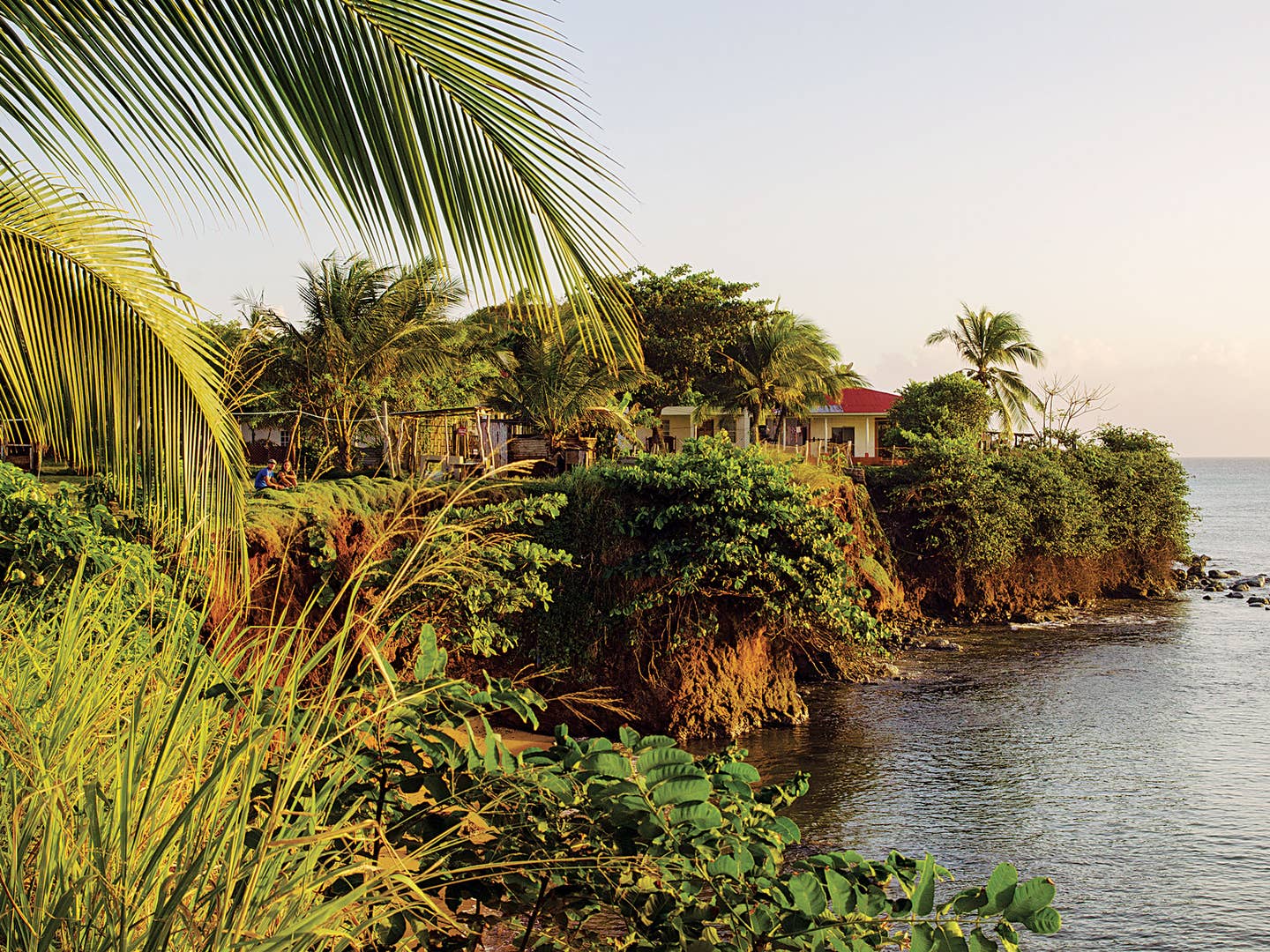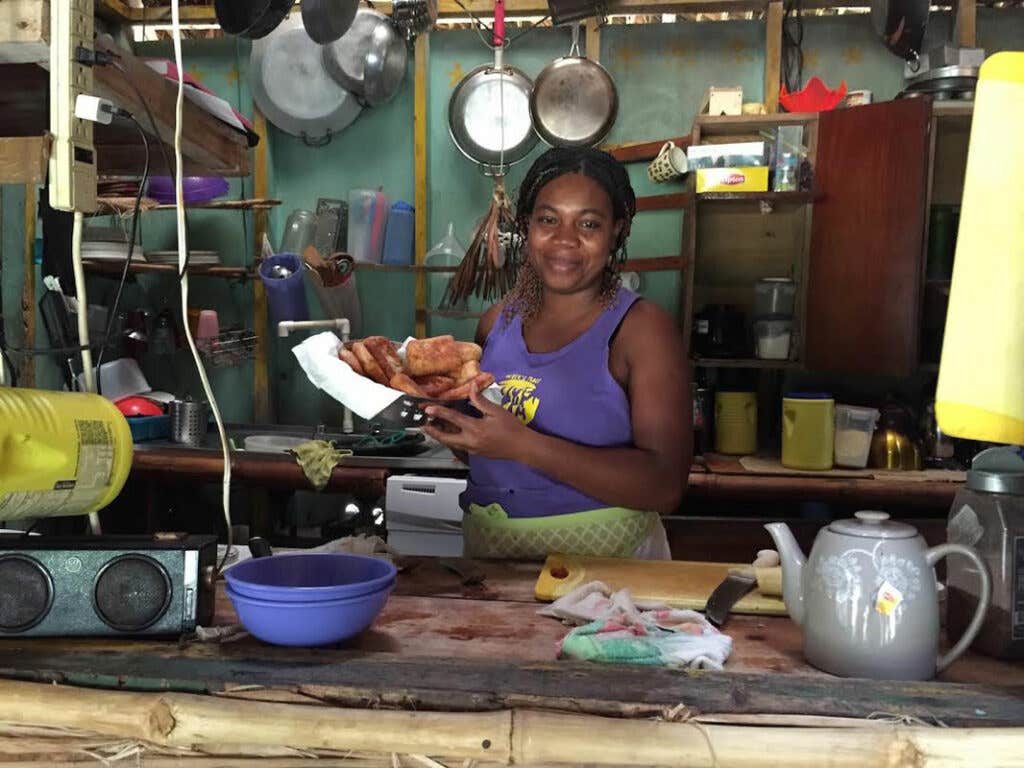
Nicaragua’s Little Corn Island Delivers Central American Flavor Without the Tourist Traps
The water is blue and the fish is fresh and the food is very, very good
It's not easy getting to Little Corn Island. The challenge is part of the charm. At least that's what my girlfriend, Danielle, and I tell ourselves as we step onto the ferry, neither of us quite noticing that it isn't really a ferry, but a working ship transporting thousands of gallons of gasoline. As the boat chugs into stomach-turning swells, diesel fumes fill the cramped passenger hold.
Seeking fresh air outside, I watch three men trolling for fish off the back of the boat, each clutching salt-crusted hand-lines. On a bench between greasy fuel drums, a gray-haired German man in wire-rim glasses has wedged himself into a child-sized life vest and stares grimly at the heaving horizon. One errant spark, his fierce look says to me, and we all go down together.
Ten miles and two-and-a-half hours later we enter the calm of Little Corn's protected harbor. Just as we do a springtime squall opens overhead. The rain falls in gray curtains and a dozen teenage boys scramble onto the ship with wooden planks they use to roll the gasoline barrels off the deck and plunk them into the glassy water below.
Danielle chose Little Corn Island as a vacation spot where the two of us could escape New York's pressure, structure, and noise. There are no taxis honking on this one square mile of land, no streetlights flashing. Electricity runs only at night. We've come for the sounds of waves, the rattling of wind in the palms, and not much else.
What we weren't expecting on this dot of sea-sprayed jungle and sand is compelling food. In most resort destinations, isolation brings overpriced and underwhelming tourist fare. But here, where the local languages include Spanish, an English patois, Garifuna, and the indigenous Miskito, we find a cuisine that is both proudly self-sustaining and utterly fresh. The majority of the food is grown on the islands—bananas, tomatoes, breadfruit, cassava, other tubers—or fished from the surrounding clear turquoise waters. Soon we find ourselves on an unexpected culinary expedition, slurping down fresh coconut juice and inhaling simply prepared ceviche at every turn.
Off the boat, we take refuge under the covered porch of the first restaurant in sight, Miss Bridget's, remove our packs, and grab a table. We order two cold Toñas and some curried yellowtail snapper, which comes with a side of crispy golden tostones (twice-fried plantains). As with most meals over the next five days, lunch blurs the lines between a commercial transaction and simply eating at someone's home. The bathroom for customers is next to the family's outdoor washboard and drying lines. The veranda at Miss Bridget's, we realize as we sip our beers, is also simply Bridget's veranda.
We dip our tostones in the curried milk and are stunned. The silky-spicy sauce, the flaky fresh snapper, the crunch of the tostones—how is this food so good? As we sop up the last drops of broth, a man in an American-flag T-shirt at an adjacent table introduces himself. This is Bridget's husband, Elvis, a fisherman, who offers to take us trolling for barra (barracuda), king fish (king mackerel), and snapper. Fish and shellfish are plentiful on Little Corn. Spiny lobsters dominate the market—their season runs from midsummer to early spring and is an economic cornerstone—and during the annual August Emancipation Day festival, locals catch blue forest crabs and cook huge pots of crab soup packed with plantains and yucca, all swimming in a rich coconut broth. Elvis tells us that Bridget will cook whatever we catch. The melody of his baritone has the ring of gospel. How could we say no? We make a date for later that week, sling our packs on our backs, and head into the rain-cooled jungle.

There are no cars on Little Corn—the only “highways” are paved wheelbarrow paths through the Village and Caribe Town. For back roads, miles of dirt trails crisscross mango forests and dead-end at rocky bluffs and coconut grove beaches. Mangoes litter the forest floor in rotting piles—we pick the good ones for tomorrow's breakfast, a kind of island grocery shopping I could get used to. The revolting noni fruit is also ubiquitous. These “hog apples” rot in mucus-colored stains on the ground and smell uncannily like blue-cheese dressing warming in the sun. But the noni fruit is also a sworn tonic for hangovers. At Yemaya, the island's lone upscale resort, they are blended with coconut and cinnamon into a palatable but pungent noni-colada.
Aimless walks and random snacks give structure to our days. We wander into Miss Esther's kitchen, a home-bakery hybrid, where a TV on a high shelf plays cartoons and we buy oven-warm coconut bread that smells like toasted coconut oil. We hide in the shade at Alfonso's as his wife presses star fruits into juice from trees in their own backyard. We follow the sounds of reggae to the weekly baseball game, where women sell us peppery fried chicken behind the bleachers and an 8-year-old boy plies the crowd with his mom's spiced beef patties, stuffed in golden-orange cornmeal pockets. Habana Libre, a Cuban standout near the harbor, serves the most delicious ceviche we have ever tasted.
At Derek's Place, the mini-resort of Ewok-esque bamboo palapas that we call home on the island's north shore, a cook, Rachel Rebeca Sambola López, introduces us to the local version of "rundown." The dish is common throughout the Caribbean, but recipes differ; in Jamaica, rundown is a slow-cooked coconut custard. On the Corn Islands and along Nicaragua's east coast, it is more like a Creole bouillabaisse, a heady broth of spices and fresh-pressed coconut milk simmered with whatever seafood the cook finds when she "runs down" to the harbor market.
“This is our food,” López says with evident pride. The golden broth she makes starts with a coconut milk base cooked down with onion, garlic, sweet pepper, curry leaf, chiles, and fresh oregano. Cassava and breadfruit are added, and finally the different types of fish she bought earlier that day at the market.
“Rundown is a hearty food,” she lilts in her Garifuna song. “When you eat, it sits heavy in your stomach.”
We try a second version at Darinia's Kitchen, where Darinia Jeanneth Bonilla Estrada has turned her modest patio into a cozy and casually charming destination. Hers, a consommé of fish broth and salty-sweet clarified coconut milk, is an elegant interpretation. She adds herbs, carrots, shrimp, and, on the night we visit, two types of fresh-caught local fish.
On one of our last days, we meet up with Elvis, as planned, to go fishing at dawn. Danielle reels in a fearsome-looking 15-pound barracuda, and with fillets to spare, we head back to Bridget's. The cook suggests barra Caribbean-style—seared and flash-roasted in spiced coconut milk, the same flavors as rundown, but prepared sans broth. After we order, we see Bridget walk out the back door with a young green coconut and a huge machete. This is slow food. We order two more Toñas and sit back. There is nothing more to do, nothing else to see. We look out at the harbor, look back at one another, and think long and hard about nothing at all.
See the recipe for Nicaraguan "Rundown" Seafood Soup »
Keep Reading
Continue to Next Story










